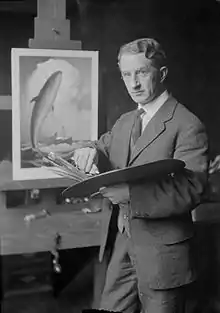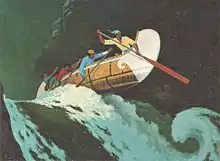Arthur Heming
Arthur Henry Howard Heming (January 17, 1870 – October 30, 1940) was a Canadian painter and novelist known as the "chronicler of the North" for his paintings, sketches, essays and books about Canada's North.
Arthur Henry Howard Heming | |
|---|---|
 Arthur Heming, 1912 | |
| Born | January 17, 1870 |
| Died | October 30, 1940 (aged 70) |
Career as an artist
Born in Paris, Ontario and raised in Hamilton, he studied in New York City and the Old Lyme Art Colony under Frank DuMond, and in London with the Welsh master Frank Brangwyn.
Heming was diagnosed as colour blind and as a result worked mostly in black and white for almost all of his life, with the addition of yellow[1] However, near the end of his career, he started to paint using the full range of colours.[2]
He was a member of the Royal Canadian Academy of Arts.[3]
A 124-page exhibition catalogue was produced by Museum London in 2013, with five academic essays, Arthur Heming: Chronicler of the North. It followed a 2012 gallery retrospective of his work, shown at Museum London.
Novels
His highly popular novels were only three in number, but they enjoyed great success in serial form and then in fine book editions from major publishers. His novels were not armchair concoctions, as Heming had travelled extensively in the wilderness ...
- "Among his northern journeys; he accompanied noted gentleman adventurer Caspar Whitney to the Barrengrounds, patrolled with the Royal North West Mounted Police in the mountains, and altogether travelled 550 miles by raft, 1000 miles by dog team, 1700 miles by snowshoe and 3300 miles by canoe."[4]

Bibliography
- Across the Sub-Arctics of Canada (1898) (James Williams Tyrrell, illustrated by Heming who was on the expedition).
- Mooswa & Others of the Boundaries (1900) By William Alexander Fraser. Illustrated by Heming. New York: Scribner's, 1900.
- The Drama of the Forests: romance and adventure (1921, novel).
- Spirit Lake (1923, novel).
- The Heming Paintings of Northern Life (1923, limited edition artbook).
- The Living Forest (1925, novel).
Heming also illustrated books by other authors, especially those of the author William Alexander Fraser (1859-1933, not to be confused with the Canadian politician of the same name).
Biographical works include: Miss Florence and the Artists of Old Lyme (1971, local history); and Arthur Heming: Chronicler of the North (2013, Museum London exhibition catalogue).
Family History
The Hemings emigrated from Bognor (Regis) England in the top half of the 19th century. Edward Francis Heming left Bognor and settled just outside Guelph, Ontario. on the Eramosa Line in 1832. He called the farm 'Bognor Lodge' and it is still there today in Heming ownership. The northern half of the farm was expropriated and flooded to make Guelph Lake.
The Heming family traces its ancestors back to King Harold Heming of Denmark, the last Viking king of Denmark, and the one who brought Christianity to Denmark. They eventually travelled through France and settled there having the town named 'Heming' after them. When France became Roman Catholic, they were/are Protestants, they emigrated again just across the English Channel to the seaside spa of Bognor.
Edward Heming had five sons in Canada West. One of them was Charles Heming and he became the postmaster of the small village of Sydenham. Because there was another growing town near Ottawa with the same name, Charles was asked to change the name of Sydenham. He changed it to 'Bognor' and it is there today. A tribute to the pioneering Canadian Heming family.
References
- "Arthur Heming". Florencegriswoldmuseum.org. 1940-10-30. Archived from the original on 2012-06-13. Retrieved 2012-07-27.
- "Tribal Life in Old Lyme: Canada's Colorblind Chronicler and his Connecticut Exile". The Public Domain Review. Retrieved 29 March 2018.
- "Members since 1880". Royal Canadian Academy of Arts. Archived from the original on 26 May 2011. Retrieved 11 September 2013.
- Michael Peake, "The Art of Heming", article at the canoe hub canoe.ca website.
- "Arthur Heming Collection". National Gallery of Canada. Retrieved September 22, 2006.
External links
| Wikimedia Commons has media related to Arthur Heming. |
- Works by Arthur Heming at Project Gutenberg
- Works by Arthur Heming at Faded Page (Canada)
- Works by or about Arthur Heming at Internet Archive
- Finding aid, Arthur Hemming collection, National Gallery of Canada Library and Archives
- Arthur Heming at Library of Congress Authorities, with 9 catalogue records